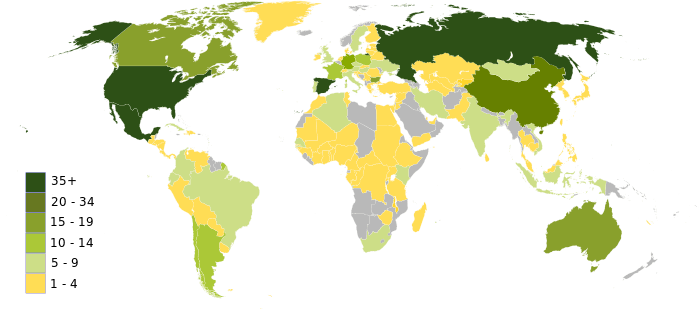World Network of Biosphere Reserves
The UNESCO World Network of Biosphere Reserves (WNBR) covers internationally designated protected areas, each known as biosphere reserves, that are meant to demonstrate a balanced relationship between people and nature (e.g. encourage sustainable development).[1]
Mission
The World Network of Biosphere Reserves (WNBR) of the MAB Programme consists of a dynamic and interactive network of sites. It works to foster the harmonious integration of people and nature for sustainable development through participatory dialogue, knowledge sharing, poverty reduction, human well-being improvements, respect for cultural values and by improving society’s ability to cope with climate change. It promotes North-South and South-South collaboration and represents a unique tool for international cooperation through the exchange of experiences and know-how, capacity-building and the promotion of best practices.
The network
As of 2016 total membership had reached 669 biosphere reserves, including 16 transboundary sites, in 120[2] countries occurring in all regions of the world.[3] Myanmar had its first biosphere reserve inscribed in 2015. This already takes into account some biosphere reserves that have been withdrawn or revised through the years, as the program’s focus has shifted from simple protection of nature to areas displaying close interaction between man and environment.
In June 2017, during the International Coordinating Council of the Man and the Biosphere Programme (MAB ICC) meeting in Paris, the United States has withdrawn 17 sites and Bulgaria 3 sites from the program. However, 23 sites were added around the world.[4]
| UNESCO region | Number of biosphere reserves |
Number of countries |
|---|---|---|
| Africa | 75 | 28 |
| Arab States | 311 | 11 |
| Asia and the Pacific | 147 | 24 |
| Europe and North America | 287 | 36 |
| Latin America and the Caribbean | 129 | 21 |
1 Includes the Intercontinental Biosphere Reserve of the Mediterranean, shared between Morocco and Spain
* Source - UNESCO, 2016[3]

References
- ↑ "UNESCO Approves 13 New Biosphere Reserves for Enhanced Protection".
- ↑ http://www.unesco.org/new/en/media-services/single-view/news/twenty_new_sites_added_to_unescos_world_network_of_biosphere_reserves/#.VaOz51-qqkp
- 1 2 "Directory of the World Network of Biosphere Reserves (WNBR)". United Nations Educational, Scientific and Cultural Organization. Retrieved 24 May 2016.
- ↑ Chow, Lorraine (16 June 2017). "US Quietly Removes 17 Sites From UN Biosphere Reserve Network". Truthout. Retrieved 16 June 2017.
External links
| Wikivoyage has a travel guide for UNESCO World Network of Biosphere Reserves. |